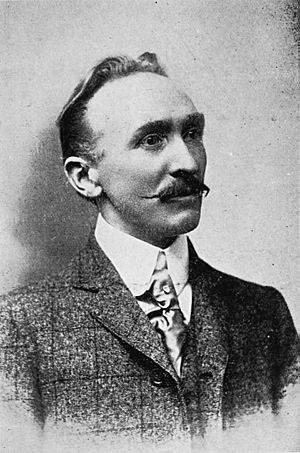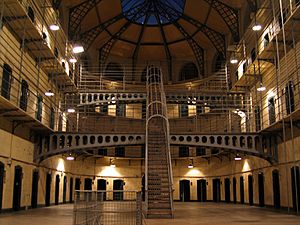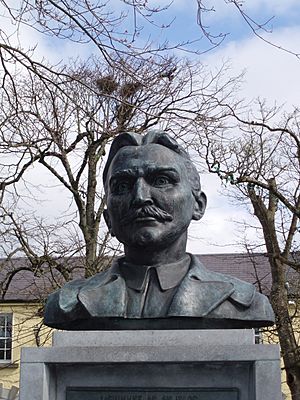John MacBride facts for kids
Quick facts for kids
John MacBride
|
|
|---|---|

Circa 1900-1916
|
|
| Born | 7 May 1868 Westport, County Mayo, Ireland |
| Died | 5 May 1916 (aged 47) Kilmainham Gaol, Dublin, Ireland |
| Allegiance | |
| Service/ |
|
| Years of service | 1899–1902 (Boers) 1913–1916 (Irish Volunteers) |
| Rank | Major second-in-command (4th battalion) |
| Commands held | 4th Battalion |
| Battles/wars | Second Boer War Easter Rising (1916) |
John MacBride (born May 7, 1868 – died May 5, 1916) was an Irish republican and military leader. He played a part in the 1916 Easter Rising in Dublin. The British government later executed him for his role in this event.
Contents
Early Life and Education
John MacBride was born in Westport, County Mayo, Ireland. His parents were Patrick MacBride, a shopkeeper, and Honoria Gill. A special plaque now marks his birthplace on the Westport Quays.
He went to school at the Christian Brothers' School in Westport. Later, he studied at St. Malachy's College in Belfast. Because of his red hair and long nose, people sometimes called him "Foxy Jack."
John first worked in a drapery shop in Castlerea, County Roscommon. He then studied medicine for a short time. After that, he worked for a chemist's company in Dublin.
He joined the Irish Republican Brotherhood, a group that wanted Ireland to be independent. He also helped start the Gaelic Athletic Association with Michael Cusack. Through the Celtic Literary Society, he met Arthur Griffith, who became a lifelong friend.
By 1893, the British government saw MacBride as a "dangerous nationalist." In 1896, he traveled to the United States for the Irish Republican Brotherhood. Later that year, he moved to South Africa.
Fighting in the Boer War
In South Africa, John MacBride joined the Boer side during the Second Boer War. He helped create the Irish Transvaal Brigade. This group was first led by an Irish-American, Colonel John Blake. MacBride suggested Blake as commander because he had no military experience himself.
The Boer government officially recognized the Brigade. MacBride was made a Major in the Boer army and became a Boer citizen. About 500 Irish and Irish-Americans fought against the British.
Sometimes, MacBride's Brigade fought against Irish regiments in the British army. These included the Royal Dublin Fusiliers. The Brigade helped protect the Boers' "Long Tom" gun. They also fought in the Battle of Colenso.
When Colonel Blake was hurt, MacBride took charge of the Brigade. Many people in Ireland supported the Boers. This support was encouraged by Arthur Griffith and Maud Gonne. However, more than 16,000 Irish people also fought for the British in this war.
Marriage and Family Life
After the Boer War, John MacBride went to Paris. There, he met and married Maud Gonne in 1903. This marriage was not approved by everyone, including the poet W. B. Yeats. Yeats had admired Maud Gonne for a long time.
In 1904, their son Seán MacBride was born. The marriage faced difficulties, and the couple separated. They disagreed about who should care for their son. Maud started divorce proceedings in Paris.
A divorce was not granted, but they agreed on a separation. Maud gained custody of their son until he was 12 years old. John was allowed to visit and have his son for one month each summer. MacBride then returned to Dublin and never saw his son again.
Maud Gonne later said that John's loneliness in Paris contributed to their marriage ending. This was especially true when she often traveled to Ireland without him.
The Easter Rising of 1916
John MacBride returned to Dublin for good in 1905. He joined other Irish nationalists who were planning an uprising. The leaders kept him out of their secret planning group because the British knew him well.
Because of this, he was not expecting the Rising when it began. On Easter Monday morning, he was in Dublin to meet his brother. His brother was arriving from Westport for a wedding.
As Major MacBride walked, he saw Thomas MacDonagh leading troops in uniform. MacBride offered to help. He was then made second-in-command at the Jacob's factory.
After the Easter Rising, MacBride faced a military trial. He was executed by a firing squad at Kilmainham Gaol in Dublin on May 5, 1916. When he faced the firing squad, he refused a blindfold. He said, "I have looked down the muzzles of too many guns in the South African war to fear death and now please carry out your sentence." He is buried in Dublin at Arbour Hill Prison.
Maud Gonne wrote to W. B. Yeats about his poem about the Rising. She said, "No I don't like your poem, it isn't worthy of you & above all it isn't worthy of its subject... As for my husband he has entered eternity by the great door of sacrifice… so that praying for him I can also ask for his prayers."
His Lasting Legacy
In November 2016, a local drama group performed a play about John MacBride's life. The play showed his time in the Boer War and his marriage to Maud Gonne. It also covered the time after his execution.
The play included poetry by Yeats. People described the opening and closing parts of the play as "very moving." A great-granddaughter of Maud Gonne's half-sister even acted in the play. The local newspaper called the play "a fitting tribute by a local drama group to a local hero."



